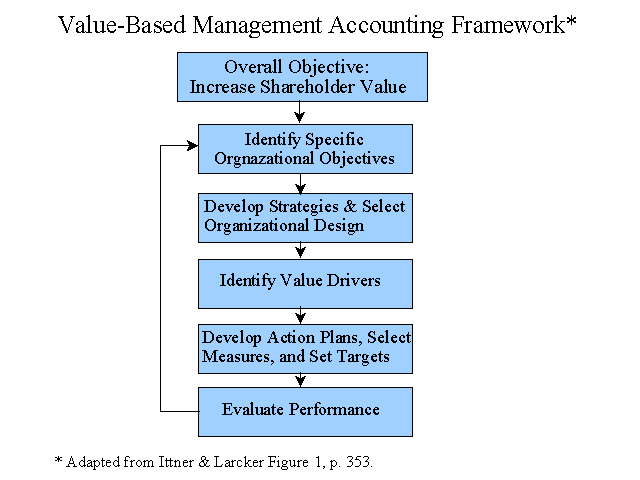Traditional accounting methods work fine for measuring a company’s financial well-being, but only to a point. Value-based management methods, on the other hand, provide alternative performance indicators and, ultimately, tools for enhancing your company’s value.
Value-Based Accounting
Value-based management tools assess the financial well-being of a business by looking at true cash flow in terms of dollars and timing. They also compare a company’s returns to its cost of capital. Two value-based measures that can directly show improvements in shareholder value are the net present value (NPV) and internal rate of return (IRR).
To measure performance using NPV, an analyst converts future cash inflows and outflows into their present values. Then he or she totals these present values into one number, the NPV. If the NPV is positive, an investment is acceptable (it will earn more than the cost of capital) – and the higher the NPV, the better the shareholder value. Conversely, investments projecting a negative NPV are typically rejected.
IRR is similar to NPV, with a few differences. For example, IRR’s net present value is zero. But like NPV analysis, IRR calculations are complex, requiring a spreadsheet or financial calculator.
Value-based tools look at returns from the investor’s viewpoint. This involves calculations factoring in cost of capital and time value of money. These calculations are complicated, requiring a more in-depth knowledge of the company’s cash flow. Like any other tools, they’re best employed by those trained and experienced in their use.
The Challenger: Traditional Accounting
Traditional accounting measures, such as an investment’s payback period, assume no difference in value from one period to another. Similarly, they don’t compare a company’s investment returns to its capital costs. They are short-term focused, thereby ignoring a company’s long-term outlook.
For instance, return on equity (ROE), a traditional financial-performance measure, examines one year’s net income. ROE, which is calculated by dividing annual net income by the book value of equity, has another problem: Net income, the numerator, differs from true cash flow. It includes noncash items, such as depreciation and amortization, without considering many other cash items, such as debt service, capital expenditures and working capital changes.
The book value of equity, the denominator, is one more ROE problem. The book value of equity is the difference between a company’s assets and liabilities. Although the values of most liabilities usually parallel their market values, asset book value is recorded at the lower of cost or market value. In other words, book value typically rests on an asset’s acquisition cost, which ignores an asset’s current value and cash flow-generating abilities.
Value Wins
Incentive programs rewarding managers who improve short-term accounting indicators often do so to the detriment of long-term financial performance and value. Instead, introduce incentive programs that reward employees for improving value-based indicators. To help ensure long-term success, please call us for help integrating value-based management analysis into your company’s strategy.
Value-Based Accounting
Value-based management tools assess the financial well-being of a business by looking at true cash flow in terms of dollars and timing. They also compare a company’s returns to its cost of capital. Two value-based measures that can directly show improvements in shareholder value are the net present value (NPV) and internal rate of return (IRR).
To measure performance using NPV, an analyst converts future cash inflows and outflows into their present values. Then he or she totals these present values into one number, the NPV. If the NPV is positive, an investment is acceptable (it will earn more than the cost of capital) – and the higher the NPV, the better the shareholder value. Conversely, investments projecting a negative NPV are typically rejected.
IRR is similar to NPV, with a few differences. For example, IRR’s net present value is zero. But like NPV analysis, IRR calculations are complex, requiring a spreadsheet or financial calculator.
Value-based tools look at returns from the investor’s viewpoint. This involves calculations factoring in cost of capital and time value of money. These calculations are complicated, requiring a more in-depth knowledge of the company’s cash flow. Like any other tools, they’re best employed by those trained and experienced in their use.
The Challenger: Traditional Accounting
Traditional accounting measures, such as an investment’s payback period, assume no difference in value from one period to another. Similarly, they don’t compare a company’s investment returns to its capital costs. They are short-term focused, thereby ignoring a company’s long-term outlook.
For instance, return on equity (ROE), a traditional financial-performance measure, examines one year’s net income. ROE, which is calculated by dividing annual net income by the book value of equity, has another problem: Net income, the numerator, differs from true cash flow. It includes noncash items, such as depreciation and amortization, without considering many other cash items, such as debt service, capital expenditures and working capital changes.
The book value of equity, the denominator, is one more ROE problem. The book value of equity is the difference between a company’s assets and liabilities. Although the values of most liabilities usually parallel their market values, asset book value is recorded at the lower of cost or market value. In other words, book value typically rests on an asset’s acquisition cost, which ignores an asset’s current value and cash flow-generating abilities.
Value Wins
Incentive programs rewarding managers who improve short-term accounting indicators often do so to the detriment of long-term financial performance and value. Instead, introduce incentive programs that reward employees for improving value-based indicators. To help ensure long-term success, please call us for help integrating value-based management analysis into your company’s strategy.

No comments:
Post a Comment